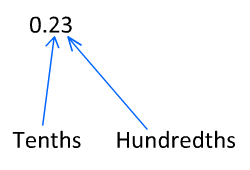Converting Percents and Decimals

Example #1: 23%
23% means 23 out of 100. We can write this as
 This is read as 23 hundredths, which is written as
This is read as 23 hundredths, which is written as 
23% = 0.23
Example #2: 48%
Let's try another. 48% =
 = 0.48
= 0.48 Example #3: 9%
9% =
 = 0.09
= 0.09
This can be tougher if the percent is less than 1% or greater than 100%.
Example #4: 0.5%
0.5% =
 = 0.005
= 0.005Example #5: 230%
230% =
 = 2.3
= 2.3
We can use place value to help us convert from decimals to percents as well.
Example #6: 0.19
0.19 is read as 19 hundredths. So we can write this as
 .
. Now that we have this written as a part out of 100, we have a percent.
0.19 = 19%
Example #7: 0.25
0.25 =
 = 25%
= 25% (In examples like this one, be sure not to reduce the fraction.
You want the denominator to be 100 to convert to a percent.)
Example #8: 0.4
0.4 =
 = 40%
= 40%Example #9: 1.3
1.3 = 1
 = 1
= 1 130%
130%Notice that when the decimal is over 1, the percent is over 100%.
Example #10: 0.003
0.003 =
 0.3%
0.3%In this example, the decimal is less than 1 one-hundredth.
Therefore, the percent is less than 1.
A Short Cut Now that you have seen why it works, here is the short cut:
To go from percent to decimal, move the decimal two times to the left.
45% = 045 = 0.45
To go from decimal to percent, move the decimal two times to the right.
0.67 = 067 = 67%
Related Links:
Math
Fractions
Factors
